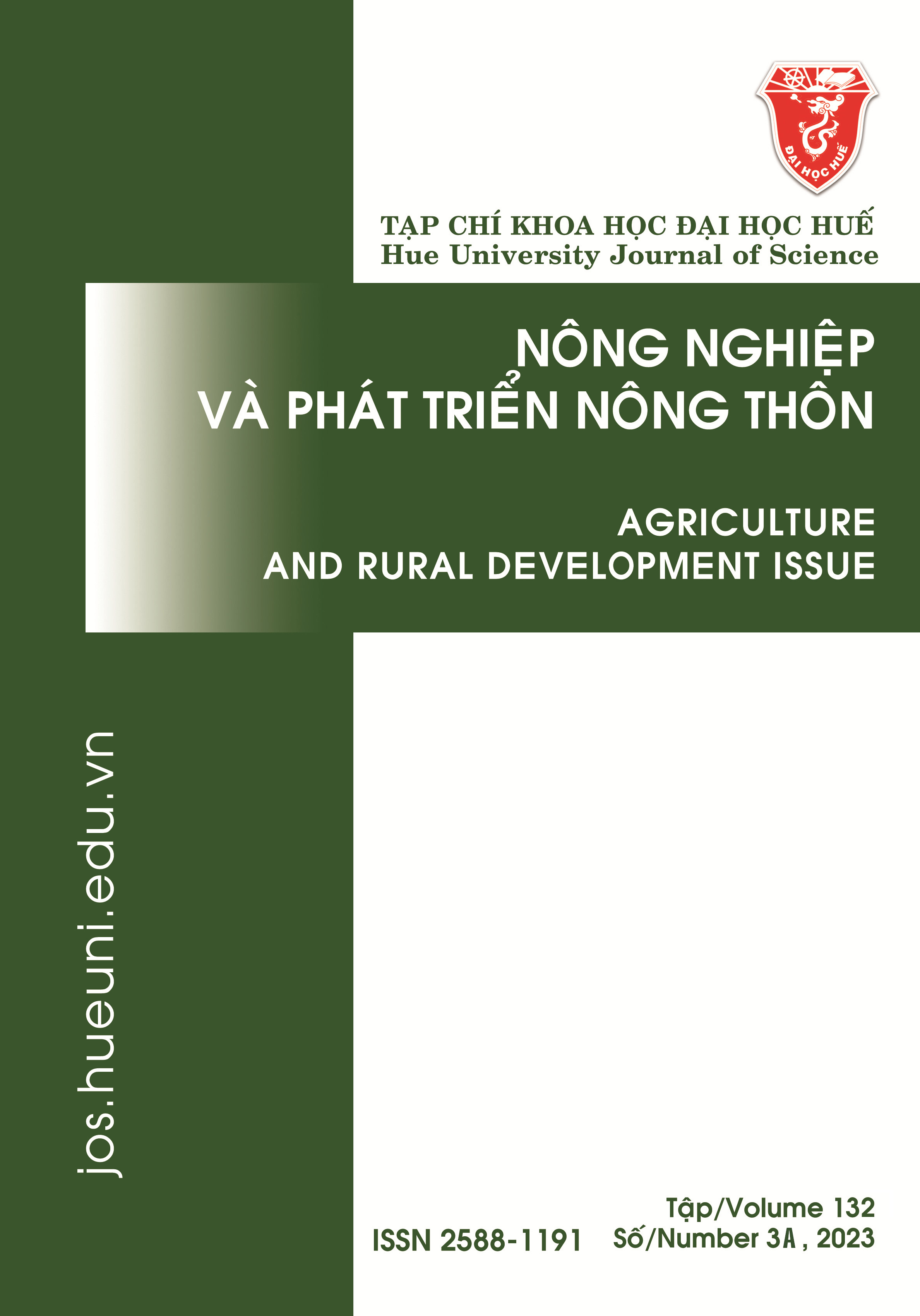Tóm tắt
Nghiên cứu được tiến hành trên 120 con cá dìa thu từ hai điểm thu mẫu trong sáu tháng. Dịch chiết từ lá và hạt cây sầu đâu với nồng độ 0, 10, 50, 100, 500 và 1000 ppm được sử dụng để đánh giá tác động lên rận cá Caligus spp. Tỷ lệ nhiễm Caligus spp. trên cá dìa là 66,7% và cường độ nhiễm trung bình là 20,3 con rận/con cá. Cường độ nhiễm lớn hơn trong tháng 1, 2 và 3 có ý nghĩa thống kê so với các tháng còn lại. Sau 30 giờ thí nghiệm, EC50 và EC90 của dịch chiết từ lá sầu đâu là 148 và 928 ppm và từ hạt sầu đâu là 62 và 397 ppm.
Tài liệu tham khảo
- Linh, N. Q., Ngoc T. N., Huyen, K. T., Giang, N. T. H. and Hue, N. V. (2015), Nutritional Characteristics and Feeding of Rabbitfish (Siganus guttatus) in Tam Giang – Cau Hai Lagoon Systems, African Journal of Agricultural Science and Technology, 5(12), 562–570.
- Boxshall, G. A. and Defaye, D. (2006), Pathogens of Wild and Farmed Fish: Sea Lice, CRC Press: Boca Raton, FL, USA.
- Dung, V. T., Glenn, A. B., Dung, N. H. and Dung, V. T. (2008), Parasitism of Two Species of Caligus (Copepoda: Caligidae) on Wild and Cultured Grouper in Viet Nam, Journal of the Fisheries Society of Taiwan, 35(1), 1–9.
- Lepe-Lopez, M., Escobar-Dodero, J., Zimin-Veselkoff, N., Azat, C. and Mardones, F. O. (2021), Assessing the Present and Future Habitat Suitability of Caligus rogercresseyi (Boxshall and Bravo, 2000) for Salmon Farming in Southern Chile, Frontiers in Veterinary Science, 7, 615039.
- Pauline, O. D., Frank, K., Suzanne, K., Tom, M. D., Jack, D. A., Joanne, C., et al. (2021), National survey of sea lice (Lepeophtheirus salmonis krøyer and Caligus elongatus nordmann) on fish farms in Ireland – 2020, Irish Fisheries Bulletin, 52, 43p.
- Cañon, J. H. A., Schlotterbeck, S. T., Castillo, R. M., Cortes, G. H., Asencio, G., Latuz, S. et al. (2021), In vitro efficacy of Quillaja saponaria extracts on the infective life-stage of ectoparasite Caligus rogercresseyi, Journal of the World Aquaculture Society, 2021(6), 1–9.
- Schmutterer, H. (2002), The Neem Tree, Azadirachta indica A. Juss and Other Meliaceous Plant Sources of Unique Natural Products for Integrated Pest Management, Medicine and Purposes, Mumbai, India, Neem Foundation, 2, 893.
- Goktepe, P. (2004), Acute Toxic Effects of Neem – Based Insecticides on Crustaceans, Bull Environ Contam Toxicol, 72, 1278–1284.
- Abhishek, K., Mani, R. P., Diwakar, M., Sunil, K. S. and Ajai, K. S. (2012), Acute toxicity of azadirachtin to a teleost, Heteropneustes fossilis, Acta Scientiarum Biological Sciences, 34(2), 213–216.
- Nguyễn Kim Phi Phụng (2007), Phương pháp cô lập hợp chất hữu cơ, Nxb. Đại học Quốc gia Tp. Hồ Chí Minh.
- Hà Ký, Bùi Quang Tề (2007), Ký sinh trùng cá nước ngọt Việt Nam, Nxb. Khoa học và Kỹ thuật, Hà Nội.
- Edward, J. N. (2010), Fish Disease: Diagnosis and Treatment, Wiley-Blackwell, 519p.
- Khoa, T. N. D., Mazelan, S., Muda, S., and Shaharom, H. F. (2019), Use of neem oil (Azadirachta indica) to control caligid copepod infestation on Asian seabass (Lates calcarifer), Aquaculture Research, 50, 1885–1892.
- Ahmet, O. and Ivan, S. (2021), Caligus minimus (Copepoda: Caligidae) parasitic on the gills of a remora echeneis naucrates attached to a seabass Dicentrarchus Labrax In Köyceğiz-Dalyan Lagoon Lake, Aegean Sea, Turkey, Annales – Series Historia Naturalis, 31-2021-1.
- Jiang, X., Hansen, H. C. B., Strobel, B. W. and Cedergreen, N. (2018), What is the aquatic toxicity of saponin-rich plant extracts used as biopesticides?, Environmental Pollution, 236, 416–424.
- Agusti, C., Bravo, S., Contreras, G., Bakke, M. J., Helgesen, K. O., Winkler, C., et al. (2016), Sensitivity assessment of Caligus rogercresseyi to anti-louse chemicals in relation to treatment efficacy in Chilean salmonid farms, Aquaculture, 458, 195–205.
- Sandra, B., Sigmund, S., Horsberg, T. E. (2008), Sensitivity assessment of Caligus rogercresseyi to emamectin benzoate in Chile, Aquaculture, 282, 7–12.
- Reverter, M., Bontemps, N., Lecchini, D., Banaigs, B. và Sasal, P. (2014), Use of plant extracts in fish aquaculture as an alternative to chemotherapy: Current status and future perspectives, Aquaculture, 433, 50–61.
